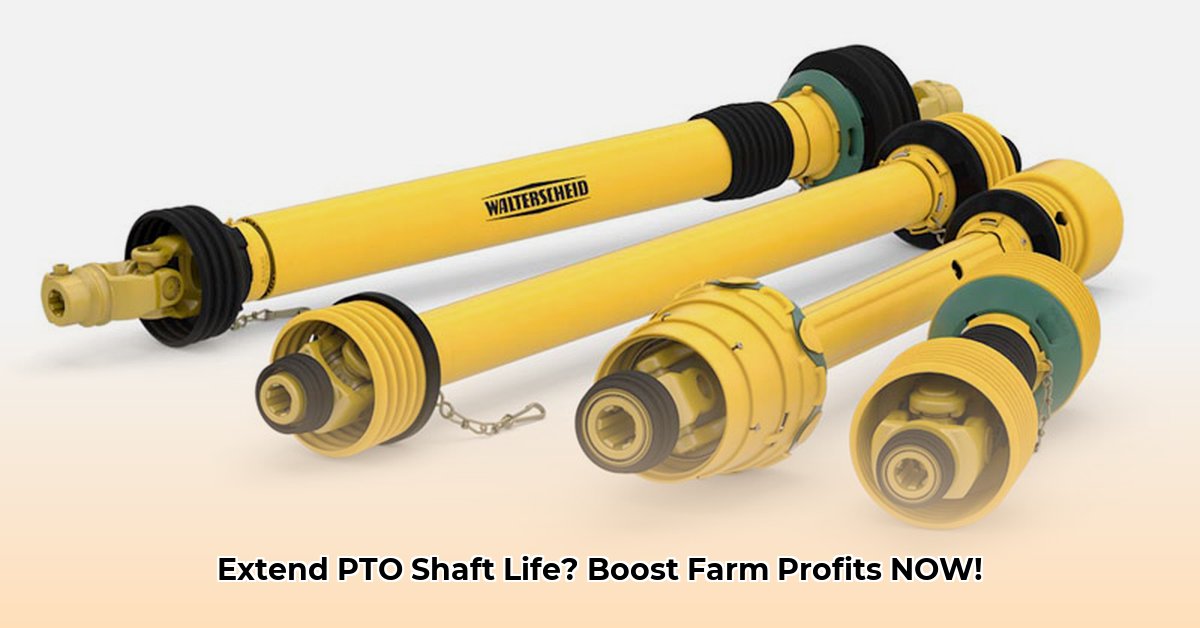
Tractor PTO Shaft: Keeping Your Farm Running Smoothly
Farm life demands peak efficiency. Downtime from a broken tractor PTO shaft translates directly to lost revenue. Proactive maintenance, however, can significantly extend its lifespan, preserving your profits. This guide provides actionable steps to keep your PTO shaft in top condition. For extended reach needs, consider a PTO shaft extender.
Understanding Your PTO Shaft: The Powerhouse Behind the Harvest
The PTO (Power Take-Off) shaft is the unsung hero connecting your tractor's power to essential implements like balers, mowers, and planters. It's a critical component ensuring smooth operation and timely harvests. Neglecting its maintenance leads to costly repairs and lost productivity.
Regular Inspections: Preventative Maintenance for Peak Performance
Regular inspections are simple yet crucial preventative measures. A few minutes of your time now can save hours and significant expense later.
Visual Inspection: Carefully examine the entire shaft for bends, cracks, excessive wear on the shaft, universal joints (U-joints), and the slip clutch. Check the protective shields for damage; missing shields pose a serious safety hazard.
Lubrication: Regularly grease the U-joints. Proper lubrication minimizes friction and extends lifespan. Think of it as reducing wear and tear on your equipment.
Tightness Check: Ensure all bolts and connections are securely tightened. Loose components can cause serious problems.
Rotation Test: With the tractor OFF, manually rotate the shaft. It should spin smoothly and quietly. Binding, stiffness, or unusual noises indicate potential issues.
Safety Shield Verification: Always confirm safety shields are correctly fitted and undamaged. Never operate the PTO shaft without them.
A Preventative Maintenance Schedule: Consistency is Key
The frequency of inspections depends on usage. This schedule provides a solid starting point:
| Inspection Type | Frequency | Focus |
|---|---|---|
| Quick Visual Check | Daily | Note any obvious damage or loose parts. |
| Thorough Inspection | Weekly | Include U-joint lubrication and tightness checks. |
| Comprehensive Check | Monthly | Examine for wear and tear; listen for unusual sounds. |
| Professional Service | Annually (or as needed) | Professional inspection and replacement of parts, if necessary. |
Isn't it a smart idea to invest a few minutes each week to prevent costly repairs and downtime, ultimately impacting your bottom line? A proactive maintenance approach is undeniably more cost-effective in the long run.
Choosing the Right PTO Shaft: Matching Your Equipment's Needs
Selecting the correct PTO shaft is essential for optimal performance and longevity.
Horsepower Compatibility: The shaft's horsepower rating must meet or exceed your tractor's output. Using an underpowered shaft risks breakage.
Length: Choose the correct length to avoid binding and stress. Incorrect length leads to premature wear.
Safety Features: Opt for shafts with built-in safety features like overload protection to safeguard your equipment and prevent injuries. How much would a single injury cost your farm?
The Return on Prevention: Why PTO Shaft Maintenance is a Sound Investment
Preventative maintenance minimizes costly breakdowns. The expense of a major repair, including downtime and potential crop loss, far surpasses the cost of regular care. This is an investment shielding your farm’s profitability and minimizing unexpected expenses.
Advanced Techniques for Prolonging PTO Shaft Longevity
Predictive Maintenance: Track usage and performance data to anticipate potential issues before they cause major problems.
Smart Technology: Sensors embedded in modern PTO shafts provide real-time monitoring and alerts, minimizing downtime.
Proactive Component Replacement: Replace worn components before complete failure to prevent larger, more expensive repairs down the road.
How to Extend PTO Shaft Lifespan Through Sustainable Maintenance Practices
Key Takeaways:
- Regular cleaning prevents abrasion.
- Consistent lubrication ensures smooth operation, reducing wear.
- Proper storage protects against corrosion and damage.
- Adhering to operational angle limits prevents stress and failure.
- Understanding PTO shaft types ensures you choose the right tool for the job.
Cleaning: Removing the Abrasive Enemies
Dirt and debris are major contributors to wear. Regularly clean your PTO shaft after each use using a wire brush, compressed air, or a parts cleaner. Focus on the U-joints and slip clutch. A clean shaft is a happy shaft.
Lubrication: Protecting Moving Parts
Regular lubrication is crucial, acting as a protective barrier. Follow the manufacturer's guidelines, but more frequent lubrication is often preferable. A smoothly functioning PTO shaft is a sign of proper maintenance.
Storage: Shielding Your Investment from the Elements
Store your PTO shaft in a dry, clean location, away from moisture, extreme temperatures, and direct sunlight. Use protective coatings or covers for added protection. This simple step can significantly extend its lifespan.
Operational Angles: Staying Within the Limits
Exceeding the maximum angle limits places undue stress on the U-joints, leading to premature wear. Consult your manual for angle restrictions and use the appropriate PTO shaft type (standard, wide-angle, or constant velocity) for each application.
Inspection: Early Detection Saves the Day
Regularly inspect for wear, damage, or misalignment. Look for cracks, bends, excessive play in U-joints, or unusual noises and vibrations. Addressing minor problems prevents them from escalating.
Understanding PTO Shaft Types: Making the Right Choice
Selecting the right PTO shaft is critical. Standard shafts suit straightforward applications, while wide-angle shafts offer greater flexibility. Constant velocity (CV) shafts maintain consistent rotational speed. Choosing the appropriate type optimizes performance and longevity.
Slip Clutch Management: Don't Overlook This Critical Component
The slip clutch protects your PTO shaft and equipment. Regularly check for proper spring compression; incorrect tension causes premature failure. Consult your manual for guidelines. By doing so, you are protecting your overall investment.